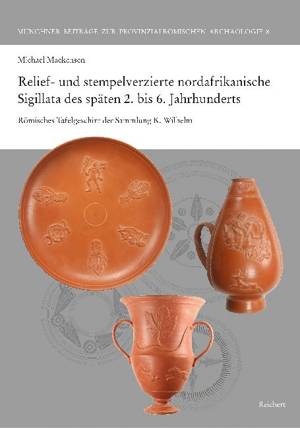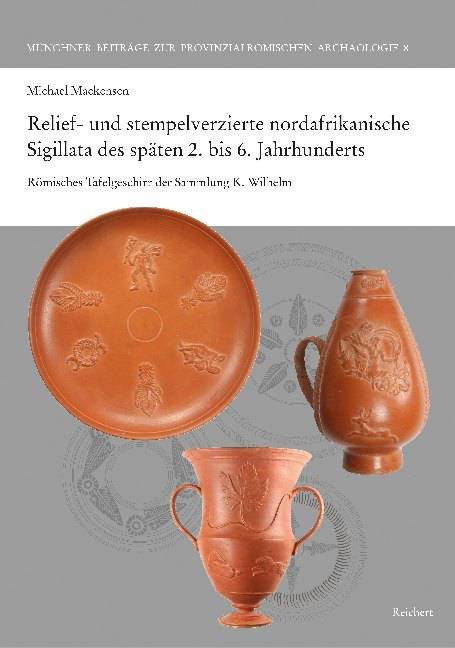
- Retrait gratuit dans votre magasin Club
- 7.000.000 titres dans notre catalogue
- Payer en toute sécurité
- Toujours un magasin près de chez vous
- Retrait gratuit dans votre magasin Club
- 7.000.0000 titres dans notre catalogue
- Payer en toute sécurité
- Toujours un magasin près de chez vous
Relief- Und Stempelverzierte Nordafrikanische Sigillata Des Spaten 2. Bis 6. Jahrhunderts
Romisches Tafelgeschirr Der Sammlung K. Wilhelm
Michael Mackensen
103,45 €
+ 206 points
Description
English summary: The study presents a summary of the development over 500 years of the high-quality North African red slip ware, a fineware which was mainly used as tableware. The masterful handicraft of several large pottery production centres in one of Rome's economically most important provinces, Africa Proconsularis, is particularly well reflected in the exceptional relief-decorated wares. The study focuses on the rare applique-decorated north Tunisian red slip ware of the late 2nd/early 3rd century and also the wide range of forms and decorations of the applique-, relief- and stamp-decorated red slip ware of the early 3rd to mid 6th century, produced in Sidi Marzouk Tounsi, the most important pottery production centre in central Tunisia which operated for at least 350 years. Production at this site included lamps and terracotta figurines in red slip ware as well, but in particular a wide variety of plain and decorated red slip ware vessels made not only for a regional market, but for Mediterranean long-distance trade.Research is based on the exceptionally extensive collection accumulated by K. Wilhelm mainly between 1960 and 1995. The material is presented in a catalogue containing 138 vessels and 104 fragments, including several unique vessel forms and a series of unknown appliques and stamp types. For comparison, some important, but partially unpublished vessels and fragments in several European, North American and North African museums and private collections were additionally taken into account.For the first time, the decoration schemes and also the vessel forms of an applique-decorated pottery produced in a north-eastern and in another central Tunisian production centre throughout the late 2nd and 3rd century, are classified and clearly represented. The research also succeeded in defining the late phase of the so-called El Aouja ware and highlights the stylistic development leading to the applique-decorated red slip ware of the 4th century. Moreover, the analysis of the applique and relief decoration with pagan, allegoric and early Christian motifs emphasises an iconographic transformation over the centuries based on the visible change in the figural scenes. Of utmost importance is the fact that the production centre at Sidi Marzouk Tounsi clearly survived the Vandal rule of the provinces Africa and Byzacena (429-533/534). Alongside the late relief-decorated red slip wares, there is now also evidence for the production of mould-made, relief-decorated red slip ware platters and several specific forms with mainly Christian motifs, far exceeding the previously suggested end of production (c. 430/440) and suggesting an end around the middle of the 6th century. German description: Die Untersuchung gibt einen Uberblick uber die etwa 500 Jahre lange Entwicklung der qualitativ hochwertigen nordafrikanischen Sigillata, einer rottonigen, rot engobierten Feinkeramik, die meist als Tafelgeschirr verwendet wurde. Insbesondere die exzeptionelle reliefverzierte Keramik spiegelt das herausragende kunsthandwerkliche Konnen mehrerer grosser Topfereizentren in einer der wirtschaftlich wichtigsten Provinzen Roms, der Africa Proconsularis, wider. Im Mittelpunkt steht die seltene applikenverzierte nordtunesische Sigillata des spaten 2./fruhen 3. Jahrhunderts und vor allem das Formen- und Dekorspektrum der appliken-, relief- und stempelverzierten Sigillata des fruhen 3. bis Mitte des 6. Jahrhunderts aus dem bedeutendsten, uber 350 Jahre produktiven zentraltunesischen Topfereizentrum Sidi Marzouk Tounsi. Dort wurde neben rottonigen Lampen und figurlichen Terrakotten ein umfangreiches, vielgestaltiges Repertoire an glatten und verzierten Sigillatagefassen nicht nur fur die Region, sondern fur den mediterranen Fernhandel hergestellt. Grundlage bietet die aussergewohnlich reichhaltige, vorwiegend zwischen 1960 und 1995 aufgebaute Sammlung von K. Wilhelm, deren Material in einem Auswahlkatalog mit 138 Gefassen und 104 Fragmenten, darunter viele Unikate und unbekannte Appliken- und Stempeltypen, dokumentiert wird. Zusatzlich wird wichtiges, teilweise unveroffentlichtes Vergleichsmaterial in europaischen, nordamerikanischen und nordafrikanischen Museen und Privatsammlungen berucksichtigt. Vor allem fur die in einem nordost- und grosstenteils in einem weiteren zentraltunesischen Topfereizentrum wahrend des spaten 2. und 3. Jahrhunderts hergestellte applikenverzierte Sigillata werden die Formen und erstmals die Dekorschemata klassifiziert und ubersichtlich dargestellt. Es gelingt auch die Spatphase der sog. El Aouja-Sigillata und die stilistischen Ubergange zur applikenverzierten Sigillata des 4. Jahrhunderts herauszuarbeiten. Die Analyse des Appliken- und Reliefdekors mit paganen, allegorischen und fruhchristlichen Motiven zeigt anhand der sich stark verandernden bildlichen Darstellungen den ikonographischen Wandel im Lauf der Jahrhunderte. Von grosser Bedeutung ist, dass das Topfereizentrum Sidi Marzouk Tounsi offensichtlich auch die vandalische Herrschaft uber die Provinzen Africa und Byzacena (429-533/534) unbeschadet uberstand. Neben der spaten stempelverzierten Sigillata, liess sich auch die Herstellung modelausgeformter, reliefverzierter Sigillataplatten und spezieller Sonderformen mit vorwiegend christlichen Darstellungen, weit jenseits des bisher angenommenen Produktionsendes (ca. 430/440) bis gegen Mitte des 6. Jahrhunderts nachweisen.
Spécifications
Parties prenantes
- Auteur(s) :
- Editeur:
Contenu
- Nombre de pages :
- 596
- Langue:
- Allemand
- Collection :
- Tome:
- n° 8
Caractéristiques
- EAN:
- 9783954904136
- Date de parution :
- 22-11-19
- Format:
- Livre relié
- Format numérique:
- Genaaid
- Dimensions :
- 218 mm x 305 mm
- Poids :
- 3043 g

Les avis
Nous publions uniquement les avis qui respectent les conditions requises. Consultez nos conditions pour les avis.






